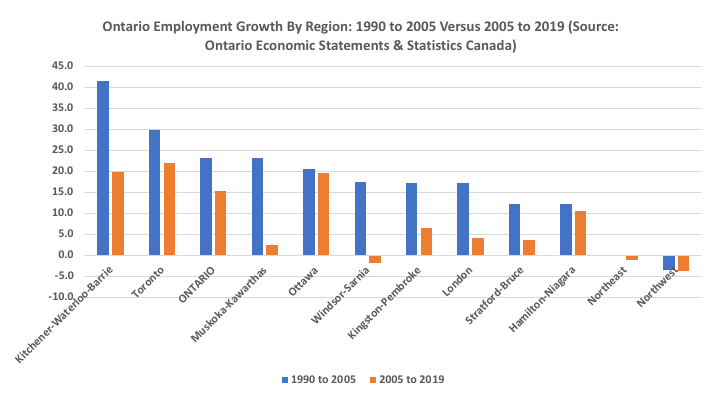Ontario government has made COVID economic pain even worse

With much of the economic attention in Ontario focused on reopening in the pandemic’s wake, it’s easy to lose sight of the long-term picture. While the pandemic was an unforeseen shock to provincial employment and income, it remains that Ontario has seen weak employment and income growth for much of the 21st century with the decline in growth rates settling in after 2005.
Consider this. From 1990 to 2005, total employment in Ontario grew 23 per cent and real per capita GDP grew by 17 per cent. However, even omitting the COVID year, going from 2005 to 2019, Ontario’s total employment grew only 15 per cent while real per capita GDP grew by 8 per cent.
In the case of employment, this pattern of slowing growth repeats itself across Ontario’s economic regions with a range that is alarming. Indeed, all Ontario economic regions saw lower employment growth from 2005 to 2019.
Specifically, Kitchener-Waterloo-Barrie saw employment grow 42 per cent from 1990 to 2005 but only 20 per cent in the subsequent 15-year period.
During these same two periods:
- Toronto went from 30 per cent to 22 per cent, Muskoka-Kawarthas from 23 per cent to about 3 per cent, Windsor-Sarnia from nearly 18 per cent to -2 per cent.
- The province’s north fared badly with the northeast going from 0 per cent to -1 per cent and the northwest from -3.6 per cent to -3.8 per cent, ultimately making for 30 years of no employment growth.
- Of all the regions, Ottawa was the most insulated, with employment growth of 21 per cent to 20 per cent.

Why the long-term slowdown in the 21st century compared to the 1990s?
One may argue that the period since 2005 saw the Great Recession but the period from 1990 to 2005 also saw the 1991-92 recession, the impact of the federal fiscal crisis and the 2001 recession. Other important factors include an aging population and lower labour force growth, a more competitive world economy and a declining provincial business investment-to-GDP ratio.
However, there’s also an important self-induced component due to growth-reducing government policies that over time have transitioned Ontario from a productive growth-oriented economy to an economy driven by real estate wealth effects.
Since 2000, a more activist and growth-reducing set of government policies have taken their toll with the most restrictive examples being the Greenbelt Act 2005 and the Far North Act 2010, which were both touted as part of growth plans. And yet, both of these acts effectively restricted the supply of available land for economic development.
The Greenbelt Act helped drive up residential housing prices in the Greater Toronto Area while the Far North Act hurt resource development in northern Ontario. In the GTA, the result has been the creation of a “rentier” sector based on scarce real estate. As for the province’s north, these policies, along with increased forestry and mining regulation, handicapped the region where it matters most—its comparative advantage in natural resources.
Moreover, Ontario saw a general rise in the regulatory burden on business at both the provincial and municipal levels including new employment standards, zoning regulations, fees and development charges. As of 2017, Ontario had the highest total cost of government regulation (per business by province) at an estimated $15 billion. That’s not to say that regulation of some kind—whether for health, environmental or employment standards—are not needed. But that in Ontario, they appear to have been implemented in a particularly inefficient and costly manner that reduced competitiveness.
The pandemic bears the blame for the fall in employment and income in 2020. But even here, Ontario’s regulatory state managed to make matters worse by implementing the longest shutdowns in Canada if not the world. This damage comes on top of what already has been a pronounced long-term trend towards reduced economic competitiveness and growth in the province.

